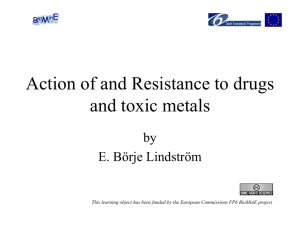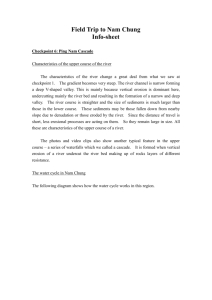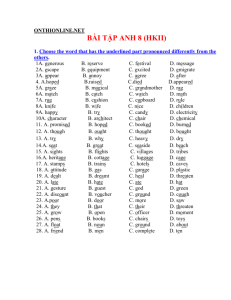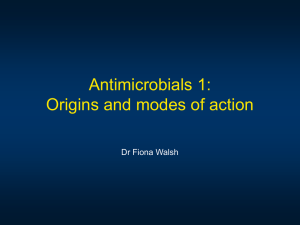The Building blocks of a bacterial cell
advertisement
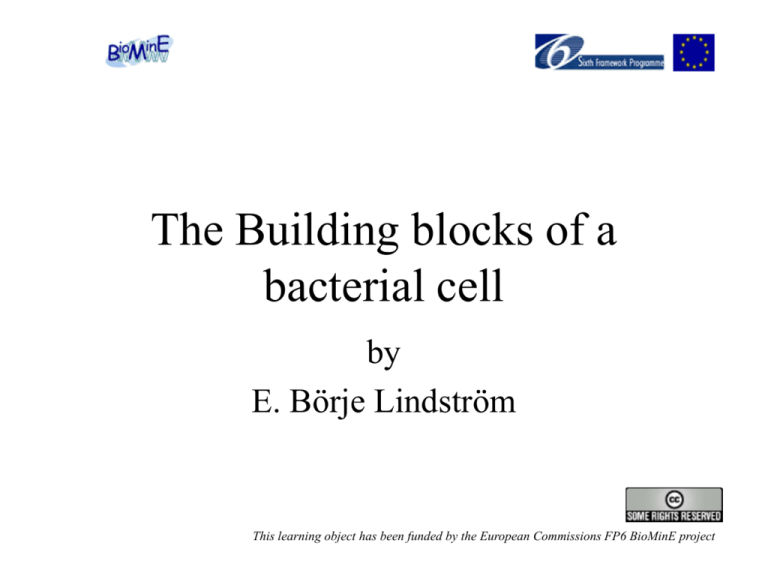
The Building blocks of a bacterial cell by E. Börje Lindström This learning object has been funded by the European Commissions FP6 BioMinE project Cell types • prokaryotes: - bacteria - archeons • eukaryotes: - yeast - algae - fungi - plant - animal Bacteria General aspects • Bacteria exist in many different forms and sizes. • Forms: - spherical e.g. Staphylococcus aureus -curved Spirilles and spirochetes or helical - rod shaped • Sizes: e.g. Escherichia coli 1 mm 1- 2 mm Depending on growth media! General aspects, cont. • Weight (dry): • Volume: • Aggregates: ~ 10-13 – 10-12 g ~ 10-12 ml - Especially among cocci - diplococci - streptococci - staphylococci - tetrads The Bacterial Cell - Schematic Cell wall Cytoplasm membrane Cytoplasm Cytoplasm • In the cytoplasm most of the biosynthesis of the cell occur. It is a suspension of: • small soluble molecules • macro molecules • particles -buildingblocks for macromolecules e.g. aa, metal salts etc. - protein/enzymes, RNA etc. - ribosomes, granula etc. Cytoplasm, cont. The ’nucleus’ - a comparison Prokaryots Eykaryotes Membrane - + Endoplasmic reticulum - + 1 >1 Cromosome(s) closed DNA (1 molecule) open DNA + proteins (histones) • Slow growth – 1-2 copies of the chromosome • Rapid growth – 2-5 copies Cytoplasm, cont. - nucleoproteins = rRNA + proteins Ribosomes - function in protein synthesis • Prokaryotes • Eukaryotes • 2 subunits 16S rRNA + 21 diff. prot 18S rRNA + 30S 40S 50S 60S 23S rRNA + 34 diff. prot ?? diff. prot 28S rRNA + ?? diff. prot 70S 80S Cytoplasm membrane Function: - selective permeability barrier - transport mechanisms - electron transport chain Properties: -unit membrane of phospholipids - ~8 nm thick - hydrofilic (glycerol) outer part - hydrophobic (fatty acids) inner part - protein inbedded (transport) - a ’floating’ structure, stabilized with Mg2+ and Ca2+ Cell Wall • Constitute ~ 10-20% of the dry weight of the baterium • almost all prokaryotes have a cell wall Funktion: - a mechanical protection - gives the cell its form Strength: - due to special chemical structures in all types of cells • cellulose – plants • chitin – fungi • mucopeptides (murein) - eubacteria Cell Wall, cont. The murein structure • a net work around the cell • carbohydrates • peptides Cell Wall, cont. Chain of carbohydrates: -alternating amin suger - NAG, N-acetyl glucoseamin - NAM, N-acetyl muramic acid NAM – NAG – NAM – NAG – NAM – NAG L-ala Peptide bond D-glu L-lys D-ala D-ala (D-ala) (aa)n D-ala L-lys aa with two amino groups (alternative DAP) D-glu L-ala NAM – NAG – NAM – NAG – NAM – NAG Gram staining Heat fixation of the cells (on a object glass) + crystal violet (blue dye) + I2-KI All cells blue + aceton/alcohol Blue cells Destained cells, grayish + safranin (red dye) G+, blue/violett cells G-, red cells Components of the cell wall • Summary: Component Gram + Gram - 15-18 nm 10 nm Teichoic acid (PO4-rich) + - Lipoprotein - + Lipopolysccharide (LPS) - + (+) (+) Murein, mucopeptide Proteins Lysozyme treatment NAM – NAG – NAM – NAG – NAM – NAG lysozyme G+: G-: - protoplast formation, cell wall completely removed - spheroplast formation, part of the cell wall left Granula • Storage of energy and carbon sources - Glykogen - Starch - b-hydroxybutyrate • Others -Polyphosphates - elementar sulphur Cell surface structures • Pili/ fimbriae: - only in G - -short protein tube - Ø ~ 7 nm - helical structure - several types e.g. F-pili - Function • Flagella: - involved in adherence to surfaces -motility organ - thin (~ 20 nm) long protein molecules - polar or peritrichious Bacterial spores • A heat resistant form of the cell (endospore) 1 cell 1 spore 1 cell • Found only in Bacillus (aerob) and Clostridium (anaerob) Capsules and slime layers • Usually a polysaccharide or protein layer excreted from the cell Function: -attachement to surfaces - protection against phagocytosis
